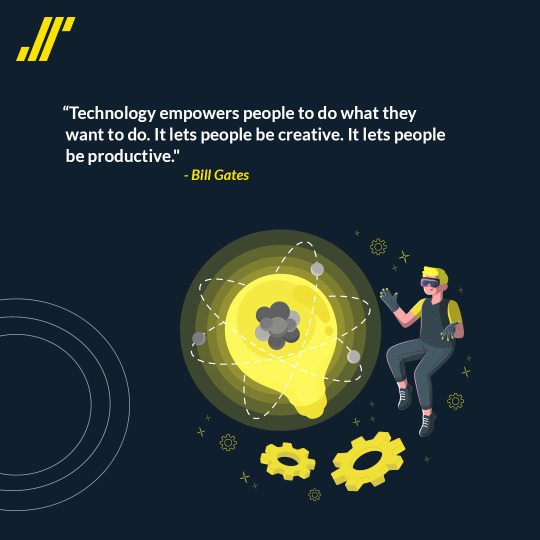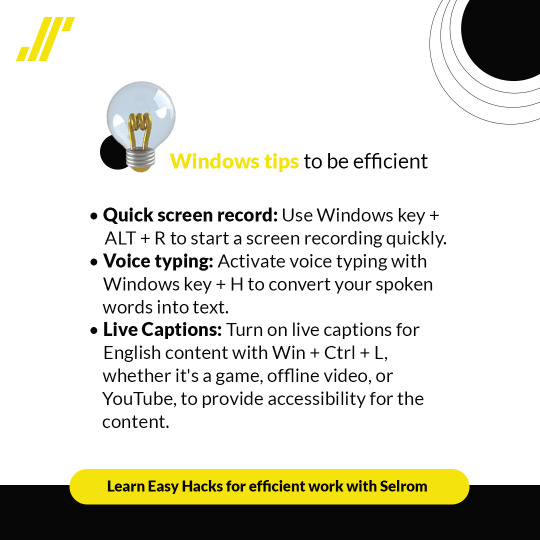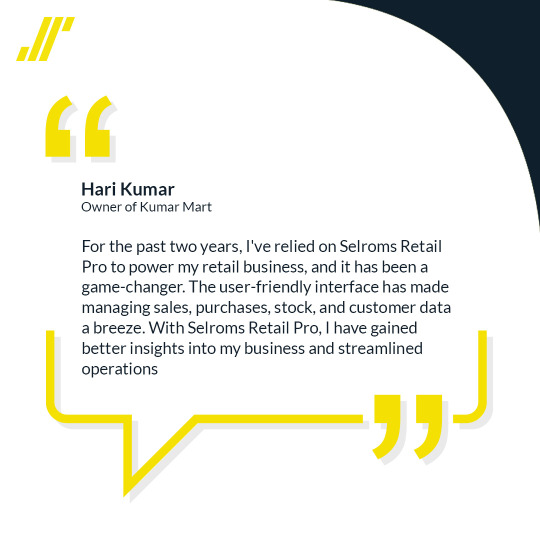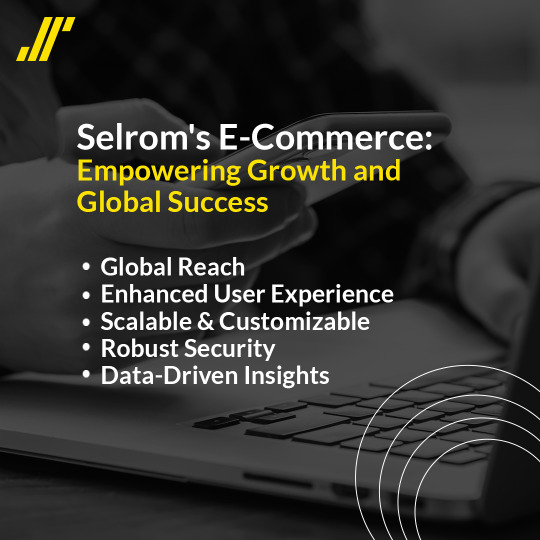#SelromSoftware
Text
Supercharge your business with Selrom's Mobile App Development services. Request a demo now and witness the power of seamless, cross-platform experiences.
Visit: www.selrom.com
#Selrom#SelromSoftware#oneworld#software#businesssoftware#mobileappdevelopment#softwarecompany#Softwares#softwaredevelopmentcompany#technology#softwaredeveloper#technologysolutions#managementsoftware#itsolution
0 notes
Text

Join #Selrom as we cherish the bonds that fuel our success. Happy Friendship Day! #ConnectedWithSelrom #FriendsInIT
Visit: www.selrom.com
#SelromSoftware#Friendshipday#Friends#software#Softwares#softwaredeveloper#softwaredevelopment#tech#erpsolutions#itsolution#technology
0 notes
Text

Embrace feedback, evolve, and excel. That’s how we pull ourselves forward. #SelromLearnings
Visit: www.selrom.com
#SelromSoftware#Saas#SelromSoftwareCompany#software#Softwares#softwaredeveloper#softwaredevelopment#tech#erpsolutions#itsolution#businesssoftware#managementsoftware
0 notes
Text

Seize the #Selrom Advantage and let’s Embrace Technology's Limitless Horizons!
Visit: www.selrom.com
#SelromSoftwareCompany#software#Softwares#softwaredeveloper#softwaredevelopment#tech#erpsolutions#itsolution#technology#SelromSoftware#Saas#mobileappdevelopment#businesssoftware
0 notes
Text
Education Software
In today's digital age, education has witnessed a remarkable transformation with the integration of technology. Education software, also known as educational technology or edtech, has emerged as a powerful tool that revolutionizes traditional teaching and learning methods. From interactive classrooms to personalized learning experiences, education software has redefined the way we acquire knowledge. In this article, we'll explore the multifaceted benefits and key features of education software, shedding light on its pivotal role in shaping modern education.
1. Introduction to Education Software:
Education software encompasses a wide range of digital tools, platforms, and applications designed to enhance and facilitate the teaching and learning process. It aims to engage students, empower educators, and create an environment conducive to effective knowledge transfer. From kindergarten to higher education, education software has found its place across various educational levels.
2. Key Features and Functionalities:
a. Personalized Learning: Education software adapts to individual learning styles and paces, tailoring content and assignments to cater to each student's strengths and areas for improvement.
b. Interactive Content: Interactive simulations, virtual labs, multimedia presentations, and gamified elements make learning engaging and dynamic, fostering better comprehension.
c. Real-time Assessment: Instant feedback and assessment tools allow educators to gauge student understanding, identify challenges, and provide timely interventions.
d. Collaborative Learning: Online discussion forums, group projects, and collaborative editing tools promote teamwork, communication, and the development of critical thinking skills.
e. Remote Learning: Education software facilitates remote and online learning, making education accessible to a broader audience regardless of geographical constraints.
f. Administrative Management: Education software streamlines administrative tasks such as attendance tracking, grade management, and scheduling, enabling educators to focus on instruction.
3. Benefits of Education Software:
a. Enhanced Engagement: Interactive and visually appealing content captures students' attention and keeps them actively engaged in the learning process.
b. Individualized Learning: Education software caters to diverse learning styles, ensuring each student receives a tailored educational experience that matches their pace and preferences.
c. Data-Driven Insights: Analytics from education software help educators identify patterns, strengths, and areas for improvement, enabling data-driven decision-making.
d. Accessibility and Inclusivity: Education software accommodates various learning abilities and provides access to education for students with disabilities.
e. Global Connectivity: Education software breaks down geographical barriers, connecting students and educators from around the world for collaborative learning.
4. Types of Education Software:
a. Learning Management Systems (LMS): LMS platforms facilitate course management, content delivery, and student engagement in both traditional and online classrooms.
b. Interactive Learning Tools: These tools include simulations, virtual labs, and educational games that create immersive learning experiences.
c. Assessment and Testing Software: Online assessment platforms enable educators to create quizzes, assignments, and exams while providing automated grading and feedback.
d. Language Learning Software: Interactive language learning software enhances language acquisition through speaking, listening, reading, and writing exercises.
e. Adaptive Learning Software: Adaptive learning platforms adjust the difficulty of content based on student performance, ensuring optimal challenge and support.
5. Future Trends and Innovations:
a. Artificial Intelligence (AI): AI-driven education software can provide real-time tutoring, personalized recommendations, and predictive analysis to enhance learning outcomes.
b. Virtual Reality (VR) and Augmented Reality (AR): Immersive experiences through VR and AR can create realistic simulations for various subjects, enhancing experiential learning.
c. Microlearning and Bite-Sized Content: Short, focused lessons delivered through education software cater to modern learners' shorter attention spans and busy schedules.
6. Conclusion:
Education software has ushered in a new era of learning, where technology serves as an enabler of innovation and engagement. Its versatility and adaptability make it a valuable asset across educational institutions, from primary schools to universities. By harnessing the power of education software, educators and students alike can explore a dynamic and personalized educational journey that fosters critical thinking, collaboration, and continuous growth. As we embrace the future of education, education software stands as a beacon of progress, empowering learners to thrive in an ever-evolving world.
#SelromSoftware#Saas#SelromSoftwareCompany#software#Softwares#softwaredeveloper#softwaredevelopment#tech#erpsolutions#itsolution
0 notes
Text

Learn Easy Hacks for efficient work with #Selrom.
Visit: www.selrom.com.
#SelromSoftware#Saas#SelromSoftwareCompany#software#Softwares#softwaredeveloper#Tips#Hacks#softwaredevelopment#tech#erpsolutions#itsolution
0 notes
Text
Clinic Management Software
In today's rapidly evolving healthcare landscape, the efficient management of clinics and healthcare facilities is crucial for delivering quality patient care. Clinic Management Software (CMS) has emerged as a powerful tool to streamline various administrative and clinical processes, enhancing overall operational efficiency and patient satisfaction. In this article, we'll delve into the benefits, key functionalities, and the transformative impact of Clinic Management Software on modern healthcare practices.
1. Introduction to Clinic Management Software:
Clinic Management Software is a comprehensive solution designed to automate and optimise various aspects of clinic operations. From appointment scheduling and patient records management to billing and reporting, CMS provides a centralised platform that simplifies the complex processes involved in running a clinic. This technology empowers healthcare providers to focus more on patient care and less on administrative tasks.
2. Key Functionalities of Clinic Management Software:
a. Appointment Scheduling: CMS allows patients to book appointments online, reducing phone call volume and administrative workload. Automated reminders and notifications help reduce no-shows and optimise resource allocation.
b. Patient Records Management: Digital patient records ensure accurate and accessible medical histories, diagnosis, treatments, and medications. CMS streamlines record-keeping, making it easier for healthcare providers to make informed decisions.
c. Billing and Invoicing: Automate billing processes, generate invoices, and manage payment transactions seamlessly. This reduces billing errors, accelerates payment collection, and enhances the financial health of the clinic.
d. Prescription Management: CMS enables electronic prescription generation and management, enhancing prescription accuracy and reducing paperwork. It also integrates with pharmacies, making prescription fulfilment efficient.
e. Inventory Management: Monitor and manage medical supplies and inventory levels in real time. Automated alerts notify staff when stock is low, reducing the risk of shortages and wastage.
f. Reporting and Analytics: Generate detailed reports on clinic performance, patient demographics, appointment history, revenue, and more. Data-driven insights aid in informed decision-making and strategic planning.
3. Advantages of Clinic Management Software:
a. Enhanced Efficiency: Automation of administrative tasks, appointment scheduling, and record-keeping reduces manual efforts, allowing staff to focus on patient care.
b. Patient-Centric Approach: CMS improves patient experience by offering online appointment booking, reducing wait times, and enabling timely access to medical records.
c. Reduced Errors: Digital records and automated processes minimise the risk of errors in prescription, billing, and patient information management.
d. Optimised Resource Allocation: Efficient appointment scheduling and resource management lead to better utilisation of clinic facilities and staff.
e. Improved Financial Management: Streamlined billing and invoicing processes enhance revenue collection and financial planning.
4. Implementation and Considerations:
a. Customization: Choose a CMS that aligns with the specific needs of your clinic. Customization options ensure the software adapts to your workflows.
b. Training and Support: Comprehensive training and ongoing support are essential to ensure a smooth transition to the new system.
c. Data Security: Prioritise a CMS with robust data security features to protect patient information and comply with healthcare regulations.
d. Scalability: Consider a CMS that can accommodate your clinic's growth and evolving needs.
e. Integration: Ensure the CMS can integrate with other systems, such as electronic health records (EHR) or pharmacy software.
5. Future Trends and Innovations:
a. Telehealth Integration: CMS is likely to integrate telehealth features, enabling virtual consultations and expanding patient access.
b. Artificial Intelligence: AI-driven insights may help clinics analyze data trends and patient outcomes for more effective decision-making.
c. Patient Engagement: CMS may incorporate patient portals for increased engagement, allowing patients to access their records and communicate with providers.
6. Conclusion:
Clinic Management Software is transforming the healthcare industry by streamlining operations, enhancing patient care, and improving overall clinic efficiency. With its myriad benefits, including appointment scheduling, patient records management, billing, and more, CMS empowers healthcare providers to focus on what truly matters: delivering quality care to their patients. As technology continues to advance, Clinic Management Software will undoubtedly play a pivotal role in shaping the future of healthcare administration and patient-centred services.
#Selrom#SelromSoftware#Saas#SelromSoftwareCompany#software#Softwares#softwaredeveloper#softwaredevelopment#tech#erpsolutions#itsolution
0 notes
Text
Pharmacy Software
In the dynamic landscape of the healthcare industry, pharmacies play a pivotal role in ensuring patients have timely access to medications and health-related products. To meet the evolving demands of patients and regulatory requirements, pharmacies are increasingly turning to advanced Pharmacy Software solutions. These software systems are designed to streamline and enhance various aspects of pharmacy operations, from inventory management to patient interactions. In this article, we will delve into the world of Pharmacy Software, exploring its functionalities, benefits, and its transformative impact on modern pharmacy management.
1. Introduction to Pharmacy Software:
Pharmacy Software is a comprehensive technology solution tailored specifically for the unique needs of pharmacies. It offers a centralized platform that integrates various pharmacy processes, including prescription processing, inventory management, patient communication, billing, and reporting. The aim of Pharmacy Software is to optimize efficiency, improve patient care, and support pharmacists in delivering quality services.
2. Key Functionalities of Pharmacy Software:
a. Prescription Processing: Pharmacy Software simplifies and accelerates prescription processing by digitizing the entire workflow. Pharmacists can receive electronic prescriptions from healthcare providers, verify patient information, and dispense medications accurately. This digital approach reduces the risk of errors and enhances the speed at which prescriptions are filled.
b. Inventory Management: Efficient inventory management is crucial for pharmacies to maintain an adequate supply of medications while minimizing wastage and stockouts. Pharmacy Software enables real-time tracking of medication stock levels, expiration dates, and reorder points. Automated alerts notify pharmacists when stock is low, ensuring timely replenishment.
c. Patient Profiles and Interaction: Modern Pharmacy Software solutions facilitate the creation and management of patient profiles. Pharmacists can record patients' medication history, allergies, and interactions, leading to safer medication dispensing. These systems also allow for personalized patient interactions, offering medication counseling, dosage reminders, and refill notifications.
d. Billing and Insurance Claims: Pharmacy Software streamlines billing processes by automating invoicing, managing insurance claims, and processing co-payments. This reduces administrative overhead and enhances the accuracy of billing, ensuring a smooth experience for both patients and pharmacies.
e. Reporting and Analytics: Data-driven insights are essential for optimizing pharmacy operations. Pharmacy Software generates comprehensive reports on sales, inventory turnover, and prescription trends. These analytics help pharmacists make informed decisions, identify opportunities for improvement, and adapt to changing market dynamics.
3. Advantages of Pharmacy Software:
a. Enhanced Efficiency: The automation and integration of various pharmacy processes significantly enhance operational efficiency. Pharmacy staff can allocate more time to patient care and clinical services, rather than being burdened by manual administrative tasks.
b. Reduced Errors and Improved Patient Safety: Pharmacy Software minimizes the chances of medication errors by digitizing prescription processing and medication dispensing. Accurate patient profiles and drug interaction checks contribute to safer medication management, ultimately improving patient outcomes.
c. Inventory Optimization: Efficient inventory management is vital to avoid overstocking or running out of essential medications. Pharmacy Software's real-time tracking and automated alerts help pharmacies maintain optimal inventory levels, reducing waste and ensuring timely availability of medications.
d. Patient-Centric Services: Pharmacy Software empowers pharmacists to provide personalized services to patients, including medication counseling, dosage reminders, and medication synchronization programs. This patient-centric approach enhances medication adherence and fosters stronger patient-pharmacist relationships.
e. Regulatory Compliance: Pharmacy regulations and compliance requirements are evolving. Pharmacy Software assists in meeting these regulatory standards by maintaining accurate records, ensuring proper documentation, and facilitating adherence to industry regulations.
4. Future Trends and Innovations:
The field of Pharmacy Software is continually evolving, with ongoing innovations aimed at further enhancing pharmacy operations. Emerging trends include the integration of artificial intelligence (AI) for predictive analytics, robotics for automated medication dispensing, and telepharmacy services to expand access to healthcare in remote areas.
5. Conclusion:In the modern healthcare landscape, Pharmacy Software has emerged as a game-changing tool for pharmacies, driving efficiency, accuracy, and patient-centric care. The integration of prescription processing, inventory management, patient interaction, and reporting functionalities into a single platform empowers pharmacists to deliver high-quality services. As technology continues to advance, Pharmacy Software solutions will play an increasingly vital role in shaping the future of pharmacy management, ensuring optimal patient care and operational excellence. Whether it's a small community pharmacy or a large retail chain, Pharmacy Software is transforming the way pharmacies operate, contributing to better patient outcomes and improved healthcare services.
#Selrom#SelromSoftware#SelromSoftwareCompany#software#Softwares#softwaredeveloper#softwaredevelopment#tech#erpsolutions#itsolution
0 notes
Text

Thank you for choosing #Selrom and placing your trust in us. Your success is our top priority, and we look forward to continuing to support you in the future.
Visit: https://selrom.com/
0 notes
Text
Hospital Management Software
In today's fast-paced and technology-driven world, the healthcare industry is constantly evolving to meet the growing demands of patients and providers alike. Hospitals and healthcare facilities face numerous challenges in managing patient care, administrative tasks, and financial operations efficiently. Fortunately, Hospital Management Software (HMS) has emerged as a powerful solution to streamline healthcare operations, enhance patient care, and improve overall efficiency. In this article, we will explore the benefits and functionalities of Hospital Management Software, highlighting how it revolutionizes healthcare administration.
Introduction to Hospital Management Software:
Hospital Management Software is an integrated information system designed to automate and manage various aspects of hospital operations. It serves as a comprehensive solution that combines administrative, clinical, and financial functionalities into a single platform. HMS enables healthcare institutions to digitize their processes, optimize workflows, and centralize data, resulting in enhanced decision-making and improved patient outcomes.
Key Functionalities of Hospital Management Software:
a. Patient Registration and Records Management: HMS allows hospitals to efficiently manage patient registration, capturing essential details like personal information, medical history, insurance details, and contact information. The software maintains a centralized electronic health record (EHR) system, enabling seamless access to patient data by authorized healthcare providers. This ensures accurate patient information, reducing the risk of medical errors and enhancing patient safety.
b. Appointment Scheduling and Queue Management: With HMS, hospitals can streamline appointment scheduling, enabling patients to book their appointments online or through mobile applications. Additionally, the software facilitates queue management, minimizing waiting times and optimizing resource utilization. Patients benefit from a more organized and efficient system, resulting in improved patient satisfaction.
c. Electronic Medical Records (EMR) and Clinical Documentation: Hospital Management Software facilitates the creation and management of Electronic Medical Records (EMRs). Healthcare providers can digitally record patient diagnoses, treatment plans, and medication history, ensuring a complete and accessible clinical documentation system. EMRs promote better communication among healthcare professionals, enabling comprehensive patient care and reducing redundant tests or treatments.
d. Pharmacy and Inventory Management: HMS includes features to manage hospital pharmacies and inventory effectively. It tracks medication stock levels, expiration dates, and reordering requirements, ensuring an uninterrupted supply of essential drugs. Efficient inventory management reduces waste, lowers costs, and minimizes the risk of medication shortages.
e. Billing and Financial Management: The financial aspect of hospital management is crucial for sustainability and growth. HMS streamlines billing processes, automating invoicing, and enabling online payment options, making it convenient for patients. Additionally, the software facilitates real-time financial reporting, allowing hospital administrators to monitor revenue, expenses, and profitability more efficiently.
Advantages of Hospital Management Software:
a. Enhanced Efficiency and Productivity: Hospital Management Software eliminates manual and time-consuming tasks, enabling staff to focus on providing quality patient care. The automation of administrative processes and streamlined workflows boost overall efficiency, resulting in increased productivity and reduced operational costs.
b. Improved Patient Care and Safety: The centralized nature of HMS ensures that healthcare providers have access to accurate and up-to-date patient information. This fosters better communication, facilitates informed decision-making, and enhances patient safety and care quality. Prompt access to critical data allows healthcare professionals to diagnose and treat patients more effectively.
c. Data Security and Compliance: Data security is paramount in the healthcare industry, and HMS employs robust security measures to safeguard sensitive patient information. The software ensures compliance with healthcare regulations and standards, such as HIPAA, protecting patient confidentiality and privacy.
d. Data Analytics and Decision Support: Hospital Management Software often comes with data analytics tools that offer valuable insights into hospital operations. Administrators can use these analytics to make data-driven decisions, identify operational inefficiencies, and plan for future growth and expansion.
e. Better Patient Engagement: HMS promotes patient engagement by offering convenient online appointment booking, access to test results, and electronic communication with healthcare providers. Engaged patients are more likely to be proactive in managing their health, leading to better treatment adherence and health outcomes.
Conclusion:
Hospital Management Software has become a game-changer in the healthcare industry, transforming how hospitals and healthcare facilities manage their operations. The integration of administrative, clinical, and financial functionalities in a single platform enhances efficiency, patient care, and overall outcomes. The benefits of HMS, including improved productivity, patient safety, data security, and decision support, have made it an indispensable tool for modern healthcare institutions. As technology continues to advance, Hospital Management Software will undoubtedly play a vital role in shaping the future of healthcare administration.
#Selrom#SelromSoftware#SelromSoftwareCompany#software#Softwares#softwaredeveloper#softwaredevelopment#tech#erpsolutions#itsolution
0 notes
Text

With Selrom's e-commerce solutions, businesses can harness these advantages to thrive in the digital landscape.
Visit: https://selrom.com/
#Selrom#SelromSoftware#SelromSoftwareCompany#software#Softwares#softwaredeveloper#softwaredevelopment#tech#erpsolutions#itsolution
0 notes
Text
Supercharge your business with Selrom's Mobile App Development services. Request a demo now and witness the power of seamless, cross-platform experiences.
Visit: www.selrom.com
0 notes
Text

5 ways to get closer to being tech savvy:
👉Use text expansion tools to automate frequently used phrases or sentences.
👉Take advantage of window management features to organise and manage multiple open windows efficiently.
👉Install a clipboard manager to store and easily access multiple items in your clipboard history.
👉Explore task automation tools like IFTTT or Zapier to create automated workflows between different apps and services.
👉Utilise a password manager to securely store and generate unique passwords for online accounts.
Visit: www.selrom.com
#SelromSoftware#oneworld#software#softwarecompany#Softwares#businesssoftware#softwaredevelopmentcompany#technology#softwaredeveloper#technologysolutions#managementsoftware#mobileappdevelopment#itsolution
0 notes
Text
Healthcare Management Software
The efficient management of operations, patient information, and administrative chores is essential for delivering high-quality treatment in the fast-paced and constantly changing environment of the healthcare business. The way healthcare facilities operate has been revolutionized by the development of healthcare management software. The importance of healthcare management software will be discussed in this article, along with how it streamlines operations, increases productivity, and ultimately improves patient outcomes.
A complete and integrated system, healthcare management software unifies many administrative and clinical duties onto a single platform. This software improves workflows, cuts down on paperwork, and lowers the possibility of errors in everything from arranging appointments and keeping track of patient records to invoicing and inventory management. Healthcare workers can spend more time on patient care by automating repetitive procedures, improving overall efficiency.
The capacity of healthcare management software to safely centralize patient information is one of its main advantages. The days of keeping records on paper, which were prone to loss or destruction, are long gone. Healthcare practitioners can access patient data in real-time with the use of electronic health records (EHR) and electronic medical records (EMR) features, facilitating better decision-making and care coordination between various departments. The availability of thorough patient histories makes it easier for medical professionals to provide individualized and knowledgeable care.
In addition, patient engagement and communication are greatly enhanced by healthcare management software. Patients can take an active role in their healthcare journey with features like patient portals and appointment reminders. They can set up appointments, get lab results, and securely contact with their medical professionals. This degree of involvement promotes empowerment and aids in the development of more solid patient-provider relationships.
Revenue cycle management and medical billing are intricate processes that call for accuracy and close attention to detail. By automating billing operations, handling insurance claims, and monitoring payment statuses, healthcare management software accelerates these procedures. By lowering the possibility of billing mistakes and ensuring a more consistent income flow for healthcare facilities, this improves financial performance.
The capability of healthcare management software to produce in-depth reports and analytics is another important feature. These reports offer insightful information on a range of operational areas of the healthcare industry, including patient demographics, appointment scheduling, treatment outcomes, and financial trends. In order to improve performance overall, healthcare administrators can use this data to pinpoint problem areas, distribute resources effectively, and make wise decisions.
Given the sensitivity of patient data in the healthcare industry, the software's security features are of the utmost importance. To guard against unauthorized access or breaches, healthcare management software uses strong security measures like encryption, access limits, and routine data backups. Such software must, by definition, adhere to laws governing the protection of healthcare data, such as HIPAA (Health Insurance Portability and Accountability Act).
The importance of smooth communication across various departments grows as healthcare facilities become larger and more complicated. Healthcare workers can easily collaborate because good interdepartmental communication is made possible by healthcare management software. This enhances care coordination and lessens the likelihood of misunderstandings or missing important information, which ultimately improves patient outcomes.
Healthcare management software can be scaled to fit a variety of healthcare environments, including tiny clinics, major hospitals, and multi-specialty centers. A future-proof solution that advances along with technology improvements is ensured by the software's ability to adapt to the changing needs of the healthcare facility.
The ability to deliver effective, patient-centered care is transformed by healthcare management software, which is a revolutionary instrument. The operational effectiveness, financial performance, and patient engagement of healthcare facilities can all be improved by automating administrative duties, centralizing patient data, and streamlining workflows. The software's strong security measures guarantee the privacy and accuracy of patient data while adhering to the strictest compliance requirements. Adopting healthcare management software is a step toward developing an integrated, technologically advanced healthcare system that puts the needs and pleasure of patients first.
#Selrom#SelromSoftware#oneworld#software#softwarecompany#Softwares#businesssoftware#softwaredevelopmentcompany#technology#softwaredeveloper#technologysolutions#managementsoftware#mobileappdevelopment#itsolution
0 notes
Text
Transform your business with Selrom's Cloud Services. Contact us now to explore the possibilities and unleash the true potential of the cloud.
Visit: www.selrom.com
#SelromSoftware#oneworld#software#softwarecompany#Softwares#businesssoftware#softwaredevelopmentcompany#technology#softwaredeveloper#technologysolutions#managementsoftware#mobileappdevelopment#itsolution
0 notes
Text

At #Selrom we make every day count, success isn't a gamble, but a commitment to delivering exceptional software experiences for every client.
Visit: www.selrom.com
#SelromSoftware#oneworld#software#softwarecompany#Softwares#businesssoftware#softwaredevelopmentcompany#technology#softwaredeveloper#technologysolutions#managementsoftware#mobileappdevelopment#itsolution
0 notes